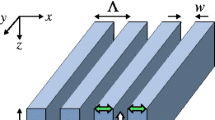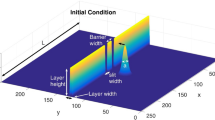Abstract
We investigate thin-slit diffraction problems for two-dimensional lattice waves. Namely, Dirichlet problems for the two-dimensional discrete Helmholtz equation on the triangular lattice in a half-plane are studied. Using the notion of the radiating solution, we prove the existence and uniqueness of a solution for the real wave number \(k\in (0,3)\backslash \{2\sqrt{2}\}\) without passing to the complex wave number. Besides, an exact representation formula for the solution is derived. Here, we develop a numerical calculation method and demonstrate by example the effectiveness of our approach related to the propagation of wavefronts in metamaterials through two small openings.




Similar content being viewed by others
References
Born M, Huang K (1954) Dynamical theory of crystal lattices. Clarendon Press, Oxford
Burke JG (1966) Origins of the science of crystals. University of California Press, Berklay and Los Angeles
Caloz C, Itoh T (2006) Electromagnetic metamaterials: transmission line theory and microwave applications: the engineering approach. Wiley, Hoboken, NJ
Brillouin L (1946) Wave propagation in periodic structures. Electric filters and crystal lattices. International series in pure and applied physics. McGraw-Hill, New York
Dove MT (2002) Structure and dynamics: an atomic view of materials. Oxford University Press, Oxford
Slepyan LI (2002) Models and phenomena in fracture mechanics. Springer, New York
Bhat HS, Osting B (2009) Diffraction on the two-dimensional square lattice. SIAM J Appl Math 70:1389–1406
Kapanadze D, Pesetskaya E (2021) Diffraction problems for two-dimensional lattice waves in a quadrant. Wave Motion 100:102671
Kapanadze D (2021) The far-field behaviour of Green’s function for a triangular lattice and radiation conditions. Math Meth Appl Sci 44:12746–12759
Horiguchi T (1972) Lattice Green’s functions for the triangular and honeycomb lattices. J Math Phys 13:1411–1419
Berciu M, Cook AM (2010) Efficient computation of lattice Green’s functions for models with nearest-neighbour hopping. Europhys Lett 92:40003
Born M, Wolf E: Principles of optics, 6th edn. (corrected). Pergamon Press, Elmsford, NY (1980)
Bouwkamp CJ (1954) Diffraction theory. Rep Progr Phys 5:321–332
Chandler-Wilde SN (1995) Boundary value problems for the Helmholtz equation in a half-plane. In: G Cohen (ed) Proc 3rd int conf on mathematical and numerical aspects of wave propagation. SIAM, Philadelphia (1995)
Chandler-Wilde SN (1997) The impedance boundary value problem for the Helmholtz equation in a half-plane. Math Methods Appl Sci 20:813–840
Chandler-Wilde SN, Zhang B (1998) A uniqueness result for scattering by infinite rough surfaces. SIAM J Appl Math 58:1774–1790
Chandler-Wilde SN, Zhang B (1998) Electromagnetic scattering by an inhomogeneous conducting or dielectric layer on a perfectly conducting plate. Proc R Soc Lond A 454:519–542
Durán M, Muga I, Nédélec JC (2006) The Helmholtz equation in a locally perturbed half-plane with passive boundary. IMA J Appl Math 71:853–876
Durán M, Muga I, Nédélec JC (2009) The Helmholtz equation in a locally perturbed half-space with non-absorbing boundary. Arch Ration Mech Anal 191:143–172
Acknowledgements
This work was supported by Shota Rustaveli National Science Foundation of Georgia (SRNSFG) [FR-21-301]
Author information
Authors and Affiliations
Corresponding author
Ethics declarations
Conflict of interest
The authors declare that they have no known competing financial interests or personal relationships that could have appeared to influence the work reported in this paper.
Additional information
Publisher's Note
Springer Nature remains neutral with regard to jurisdictional claims in published maps and institutional affiliations.
Appendix A: Sparse matrices
Appendix A: Sparse matrices
The sparse matrices \(\alpha _n(k)\), \(\beta _n(k)\), and \(\gamma _n(k)\) are defined as follows: if \(n=2p\) then \(\alpha _{2p}(k)\) is a \((p+1)\times p\) matrix such that \(\alpha _{2p}(k)\mid _{i,i}=1\), \(i=\overline{1,p}\), \(\alpha _{2p}(k)\mid _{i,i-1}=1\), \(i=\overline{2,p}\), while \(\alpha _{2p}(k)\mid _{p+1,p}=2\), and all other matrix elements are zero. The \(\beta _{2p}(k)\) is a \((p+1)\times (p+1)\) matrix such that \(\beta _{2p}(k)\mid _{i,i}=1\), \(i=\overline{1,p}\), \(\beta _{2p}(k)\mid _{i,i+1}=1\), \(i=\overline{2,p}\), while \(\beta _{2p}(k)\mid _{p+1,p+1}=\beta _{2p}(k)\mid _{1,2}=2\), and all other matrix elements are zero. The \(\gamma _{2p}(k)\) is a \((p+1)\times (p+1)\) matrix such that \(\gamma _{2p}(k)\mid _{i,i}=6-k^2\), \(i=\overline{1,p+1}\), \(\gamma _{2p}(k)\mid _{i,i+1}=\gamma _{2p}(k)\mid _{i,i-1}=-1\), \(i=\overline{2,p}\), and \(\gamma _{2p}(k)\mid _{1,2}=\gamma _{2p}(k)\mid _{p+1,p}=-2\).
If \(n=2p+1\) then \(\alpha _{2p+1}(k)\) is a \((p+1)\times (p+1)\) matrix such that \(\alpha _{2p+1}(k)\mid _{i,i}=1\), \(i=\overline{1,p+1}\), \(\alpha _{2p+1}(k)\mid _{i,i-1}=1\), \(i=\overline{2,p+1}\), and all other matrix elements are zero. The \(\beta _{2p+1}(k)\) is a \((p+1)\times (p+2)\) matrix such that \(\beta _{2p+1}(k)\mid _{i,i}=1\), \(i=\overline{1,p+1}\), \(\beta _{2p+1}(k)\mid _{i,i+1}=1\), \(i=\overline{2,p+1}\), while \(\beta _{2p+1}(k)\mid _{1,2}=2\), and all other matrix elements are zero. The \(\gamma _{2p+1}(k)\) is a \((p+1)\times (p+1)\) matrix such that \(\gamma _{2p+1}(k)\mid _{i,i}=6-k^2\), \(i=\overline{1,p}\), \(\gamma _{2p+1}(k)\mid _{p+1,p+1}=5-k^2\), while \(\gamma _{2p+1}(k)\mid _{i,i+1}=-1\), \(i=\overline{2,p}\), \(\gamma _{2p+1}(k)\mid _{i,i-1}=-1\), \(i=\overline{2,p+1}\), and \((\gamma _{2p+1}(k)\mid _{1,2}=-2)\). Finally, \(\gamma _1(k)\) is a \(1\times 1\) matrix with an element \(4-k^2\).
Rights and permissions
Springer Nature or its licensor (e.g. a society or other partner) holds exclusive rights to this article under a publishing agreement with the author(s) or other rightsholder(s); author self-archiving of the accepted manuscript version of this article is solely governed by the terms of such publishing agreement and applicable law.
About this article
Cite this article
Kapanadze, D., Pesetskaya, E. Half-plane diffraction problems on a triangular lattice. J Eng Math 138, 5 (2023). https://doi.org/10.1007/s10665-022-10252-5
Received:
Accepted:
Published:
DOI: https://doi.org/10.1007/s10665-022-10252-5




